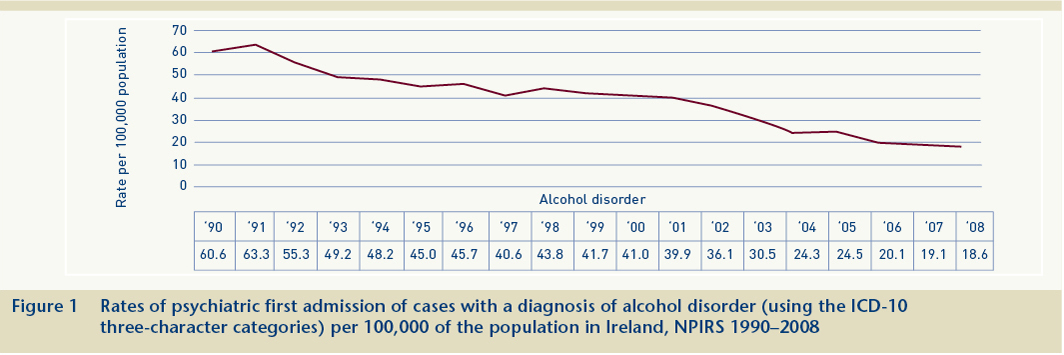Long, Jean
(2010)
Trends in alcohol and drug admissions to psychiatric facilities.
Drugnet Ireland,
Issue 33, Spring 2010,
pp. 14-15.
Activities of Irish psychiatric units and hospitals 2008,the annual report published by the Mental Health Research Unit of the Health Research Board in December 2009, shows that the total number of admissions to inpatient care has continued to fall.1
In 2008, 2,497 cases were admitted to psychiatric facilities with an alcohol disorder, of whom 789 were treated for the first time. Figure 1 presents the rates of first admission between 1990 and 2008 of cases with a diagnosis of alcohol disorder, per 100,000 of the population.1-7 It is notable that the rate decreased fairly steadily in the years 1992 to 2004 and more than halved over the reporting period. The rate stabilised in 2004 and 2005, but decreased again in the years 2006 to 2008. The trend since the early nineties reflects changes in the policy and practice of alcohol treatment, and the resultant increase in community-based and special residential alcohol treatment services. Of the 2,392 discharges of cases with an alcohol disorder in 2008, just under 42% spent less than one week in hospital and 19% spent more than one month in hospital. Whether or not these admissions were appropriate, and in line with the recommendations of the mental health policy, A vision for change, could not be discerned from the report as the numbers with co-morbid illness were not reported.

In 2008, 778 cases were admitted to psychiatric facilities with a drug disorder, of whom 289 were treated for the first time.The report does not present data on drug use and psychiatric co-morbidity, so it is not possible to determine whether or not these admissions were appropriate. Figure 2 presents the rates of first admission between 1990 and 2008 of cases with a diagnosis of drug disorder, per 100,000 of the population.1-6 The rate was almost three times higher in 2001 than it was in 1990. Notable dips in the rate occur in the census years 1996, 2002 and 2006, and can be partly explained by the increased population figure used as the denominator in calculating the rate for those years.
The overall increase in the rate of drug-related first admissions between 1990 and 2001 reflects the increase in problem drug use in Ireland and its burden on the psychiatric services. The overall decrease in the rate since 2001 possibly reflects an increase in community-based specialised addiction services during this period. The increased rate in 2005 may be accounted for by the use of the 2002 census figure in calculating the rate. The decrease to 5.9 in 2006 reflects the new census figure used as denominator. The rate increased marginally to 6.8 in 2008. Of the 791 discharges with a drug disorder, 51% spent less than one week in hospital and just under 15% spent more than one month in hospital.

2. Daly A, Walsh D and Moran R (2008) Activities of Irish psychiatric units and hospitals 2007. Dublin: Health Research Board.
3. Daly A, Walsh D and Moran R (2007) Activities of Irish psychiatric units and hospitals 2006. Dublin: Health Research Board.
4. Daly A, Walsh D, Ward M and Moran R (2006) Activities of Irish psychiatric units and hospitals 2005. Dublin: Health Research Board.
5. Daly A, Walsh D, Comish J, Kartalova-O’Doherty Y, Moran R and O’Reilly A (2005) Activities of Irish psychiatric units and hospitals 2004. Dublin: Health Research Board.
6. Daly A, Walsh D, Moran R and Kartalova-O'Doherty Y (2004) Activities of Irish psychiatric services 2003. Dublin: Health Research Board.
7. Walsh D and Daly A (2004) Mental illness in Ireland 1750–2002: reflections on the rise and fall of institutional care. Dublin: Health Research Board.

